dduelin
Site Supporter
After riding Kebrider's 700 with a set of Cogent Dynamic Drop-in Damping Cartridges I decided the results were good enough to order a set for my NC700X. I took some pictures during the install that may help illustrate how easy the upgrade is.
First, I dropped the forks out of the bike. Rick of Cogent has some pictures on his website showing an install in a bike with the forks still in the bike. It can be done but I wanted to flush the old fork oil out and the forks need to come out for that. I usually change fork oil every 15 to 20,000 miles and I detailed this August 2013 in this thread: http://nc700-forum.com/forum/garage-mechanical-help/3748-fork-oil-change.html. Consult this thread for pics and details on removing the forks and cleaning out the old oil and goop that collects at the bottom of the fork legs. It's surprising how quickly fork oil gets dirty.
This is what the fork tubes look like under the steel lower triple clamp. A nice benefit of regular fork oil changes is controlling the corrosion hidden under the clamp. This happened in 14 months since the August 2013 oil change:
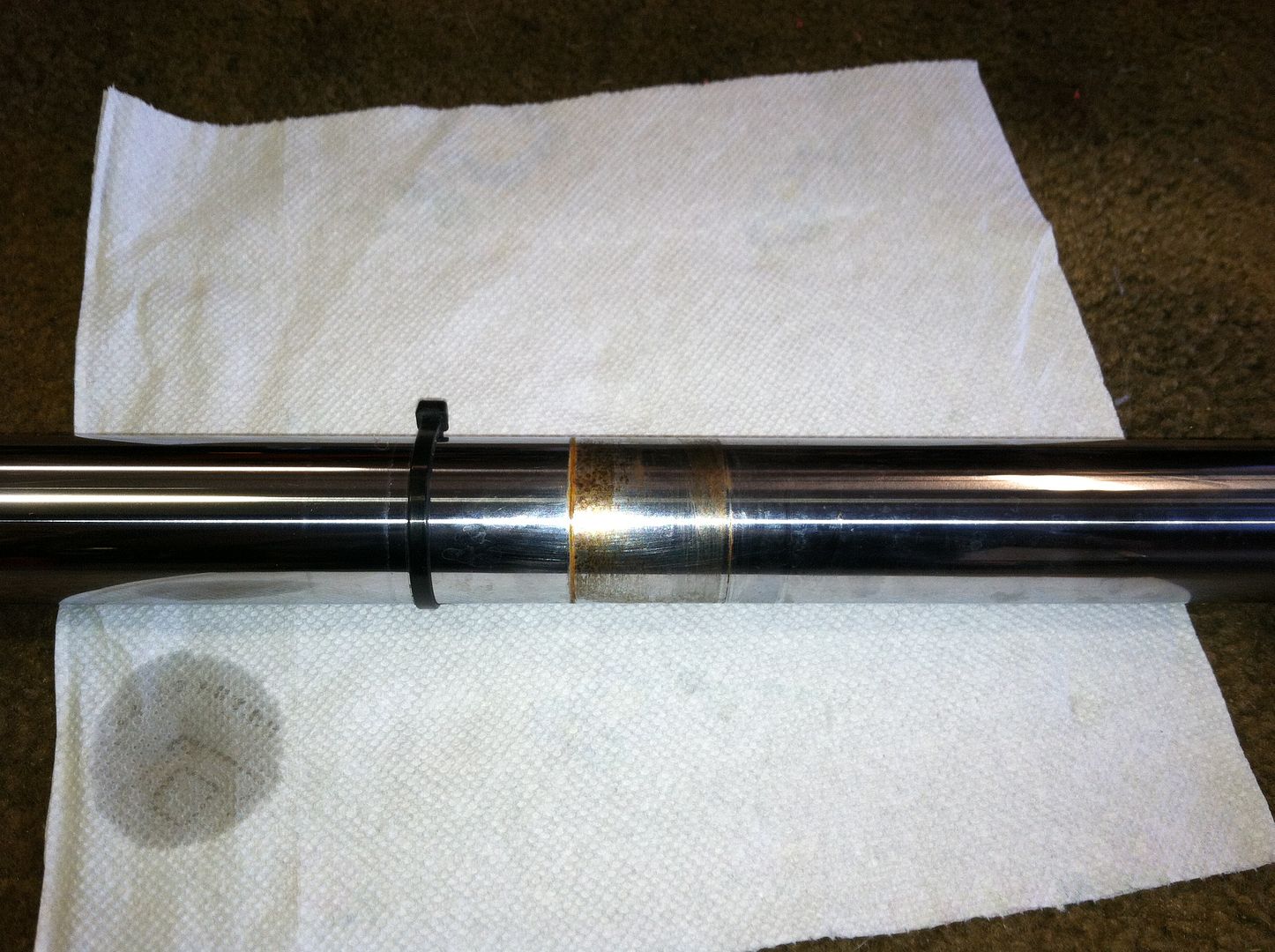
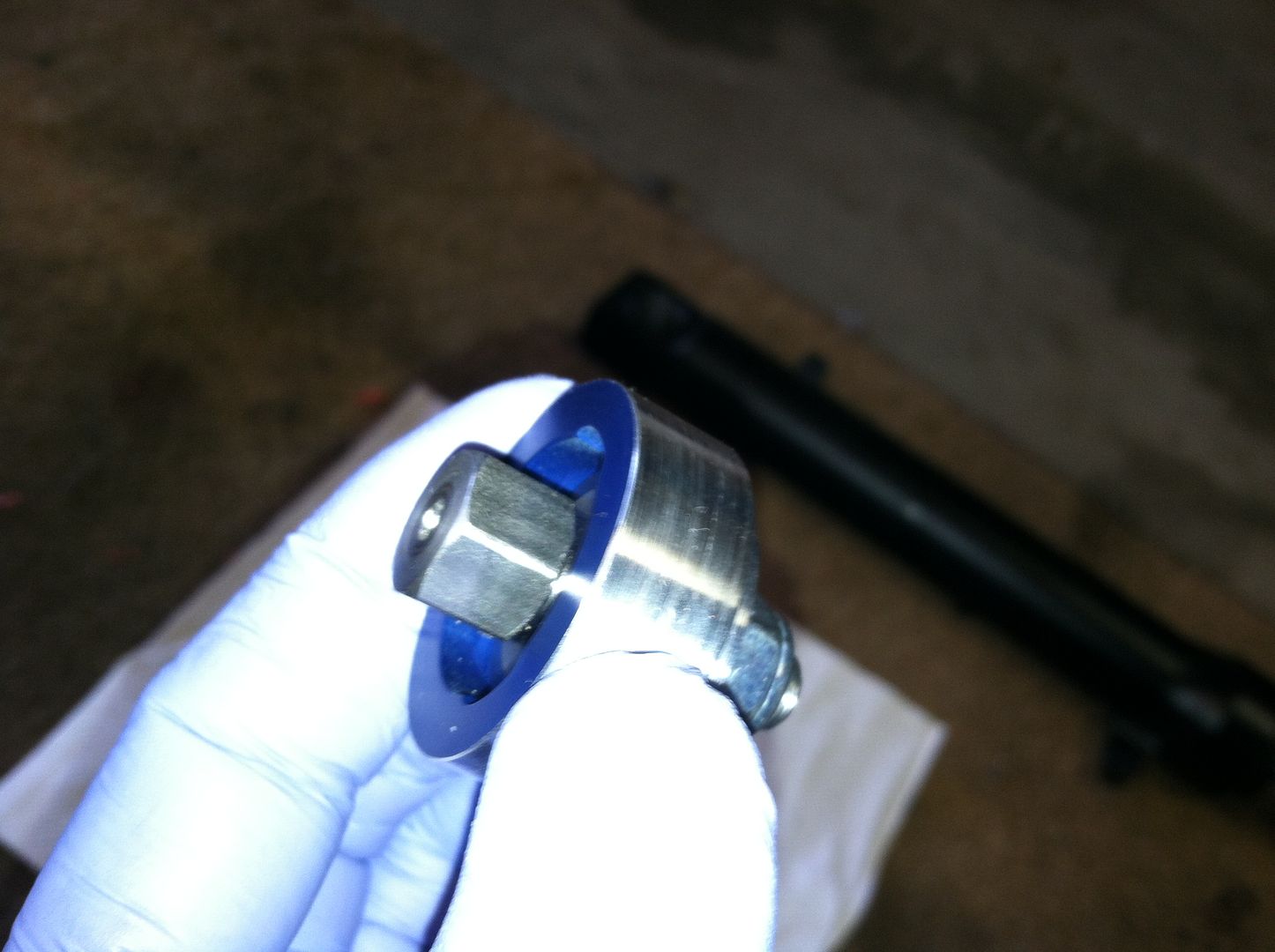
This is one of the Drop-in Damping Cartridges. It is very well made and finished. It's a round piece of aluminum with a large hole in it. Filling the hole is a stack of thin steel shims held in place with that bolt and nut. The bolt has a hole drilled down through the middle of it. It's going to fit closely the inner diameter of the fork tube and sit right under the spring and block the flow of oil as the fork collapses and extends. The hole is designed to pass enough oil to slow (dampen) the fork collapse and extension when in response to a bump or under braking. If the fork collapses slowly as in gentle braking or as when rolling over a small bump the central hole passes enough fork oil to make the damping soft and gentle. If the bump is sharp and quick the shims in the DDC deflect or bend under the rapid rise in oil pressure and enlarge the passage so the oil can still pass through fast enough to gently dampen the bump. That is the main problem I had with the stock fork. I'm 150ish lbs and over small bumps the stock fork worked very well but over a sharp quick or large bump the fork could not dampen the bump fast enough and much of the bump was passed directly to me thru the handlebars and seat as the fork became hydraulically locked and unable to compress fast enough. A suspension tuner would call this good slow speed damping but poor high speed damping with the speed referring to the speed of the fork movement absorbing the bump - not the speed of the bike. The DDC and other cartridge emulators like it (Race Tech, Ricor, others) act to modify the flow rate of fork oil in response to the speed of fork movement in relation to the magnitude of the bump. If the hole (orifice to be technical) is made permanently large enough to give good high speed damping then it would not dampen the slow speed compressions at all. The shims allow tuning to the need of the moment.
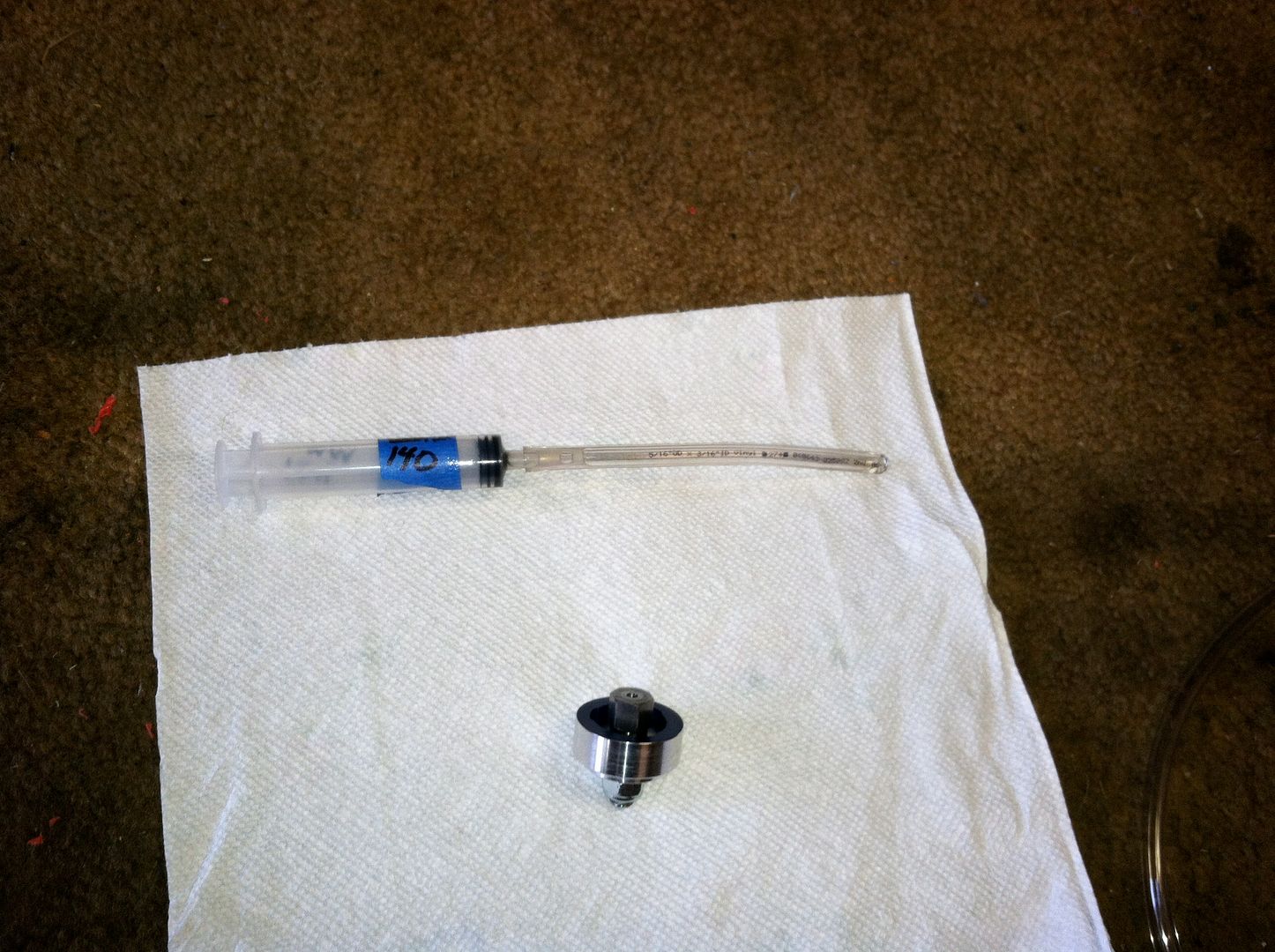
You might recognize my home-made oil level tool made of a syringe and a piece of vinyl tubing cut to the length desired. Rick told me to try 130 to 150 mm for the oil level. This level is measured from the top edge of the fork tube down to the top of the oil, fork collapsed, no spring or washers installed. The stock oil level is 104 mm IIRC but Rick told be to try 130 to 150 mm. I set the tool up for 140 mm. The DDC is also pictured. The DDC is a slip fit in the tube but I had to make sure it was seated on top of and centered on top of the stock damping tube. Cogent Dynamics sells a magnet on a stick for this but I had a pick-up magnet that extends long enough to work here:

Now with the fork upright and collapsed I slid the DDC into place and slipped the fork spring over the magnet tool. With the spring in place on top of the DDC I pulled the magnet out.
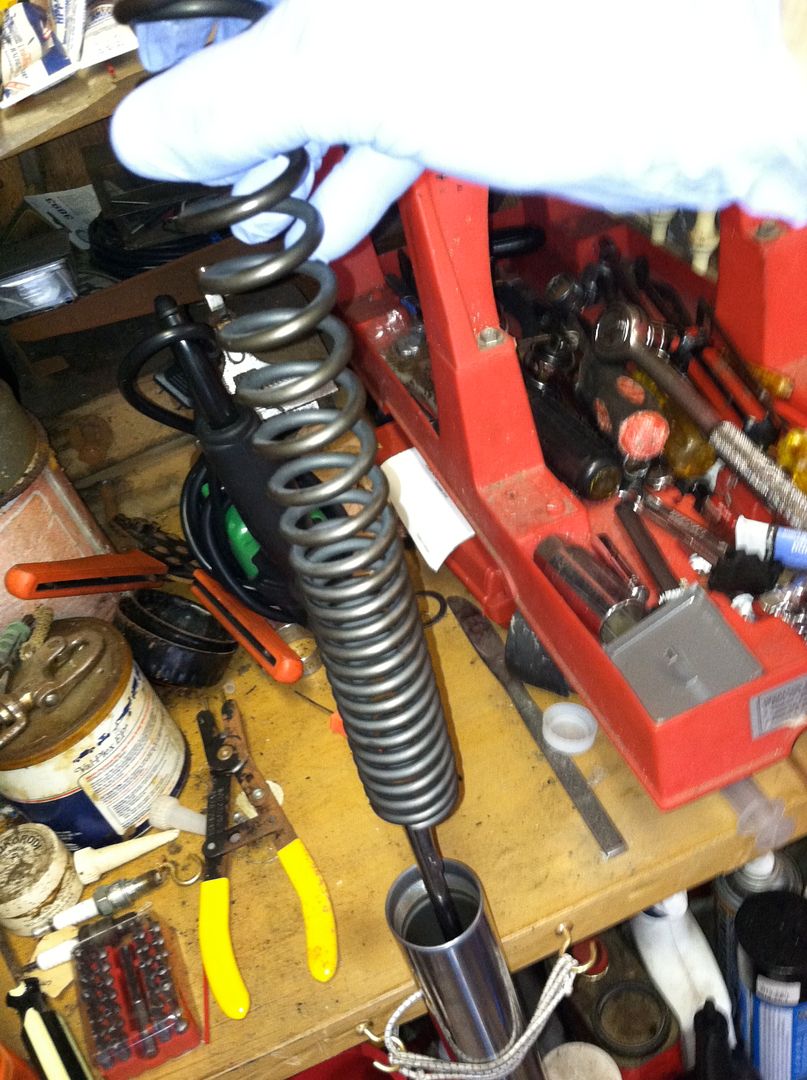
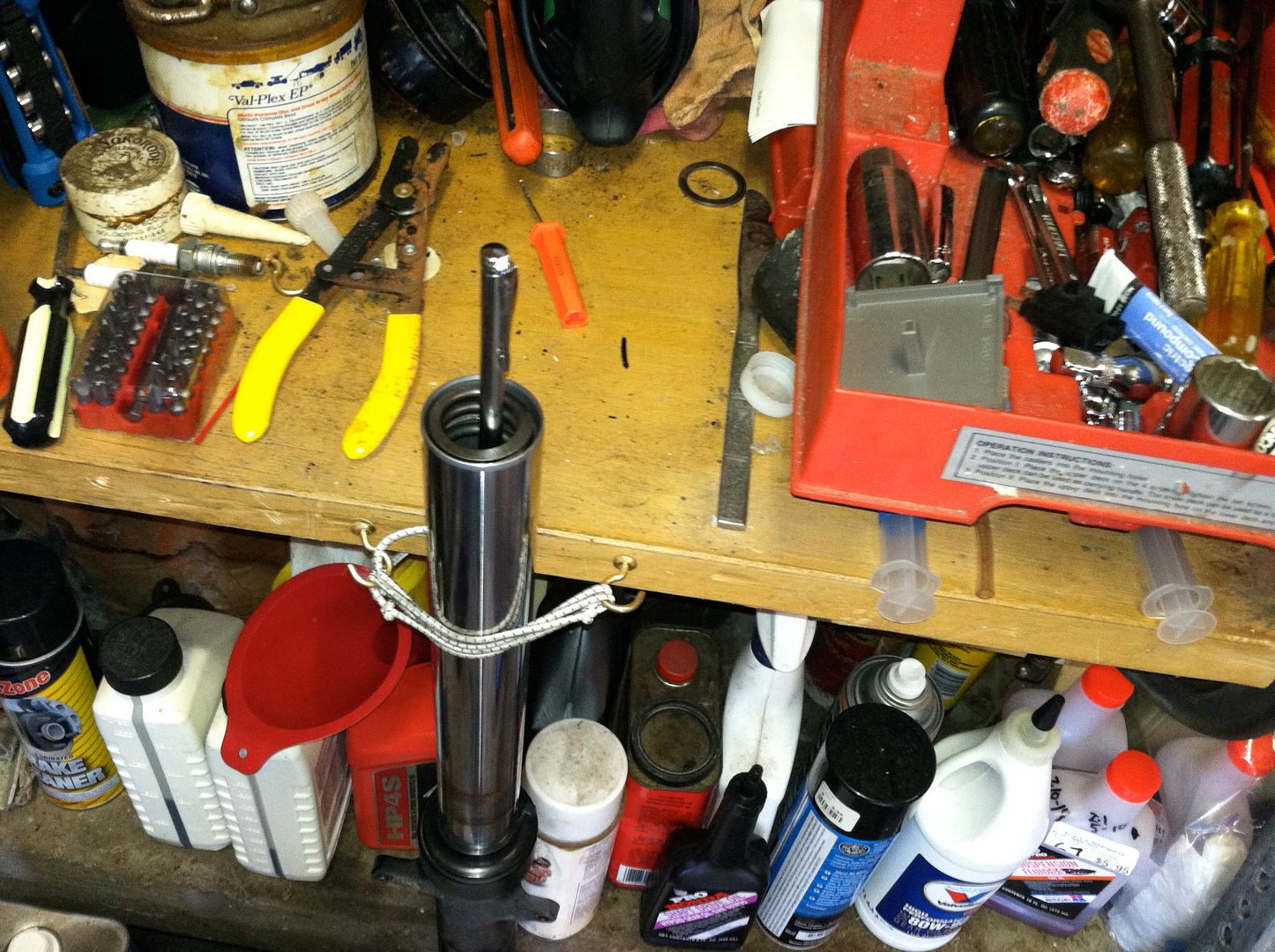
I'll back up here a bit. With me in full riding gear the fork sagged 55 mm under the weight of bike and rider. This is static or rider sag. 55 mm is 40% of the available fork travel of 137 mm and is quite a lot, really too much. Most tuning guides suggest 25 to 33% of travel and my target was 45 mm or 33%. Even though I knew the original sag was too much I never did anything about it mainly due to my height and inseam plus the bike seemed to work OK with it from the beginning. Without adjustable preload forks the way to adjust sag is to make shorter or longer spacers (Honda calls them spring collars) to fit on top of the springs. I lived with the large sag numbers from mile 1 to mile 27,701 mainly due to my short stature and short inseam. I barely touch the toes of both feet down and raising the front of the bike 10 mm was something I didn't want to do so I lived with it. The 700X has a large amount of travel compared to most street bikes and 33% would work well if I dropped the clamps down the fork tubes the same amount I reduced sag. This will preserve my reach to the ground and keep the fork/frame steering geometry the same. The DDC is 12 mm thick so I thought this additional thickness in the spring stack when in the fork would raise the ride height a large portion of 12 mm and get the sag from 55 to close to 45 mm. With this math in mind (55-12mm =43 mm plus the change would not be linear due to the stock spring's progressive windings) I reused the stock spacers of 150 mm and expected the sag to come out around 45 mm when all was done. I filled with the Cogent Dynamic-recommended Golden Spectro 85/150 oil to the level of 140 mm and after installing the washer and spacer on top of the spring I tightened down the fork caps. I buffed the rust off the tubes with a piece of very fine Scotchbrite and WD40:
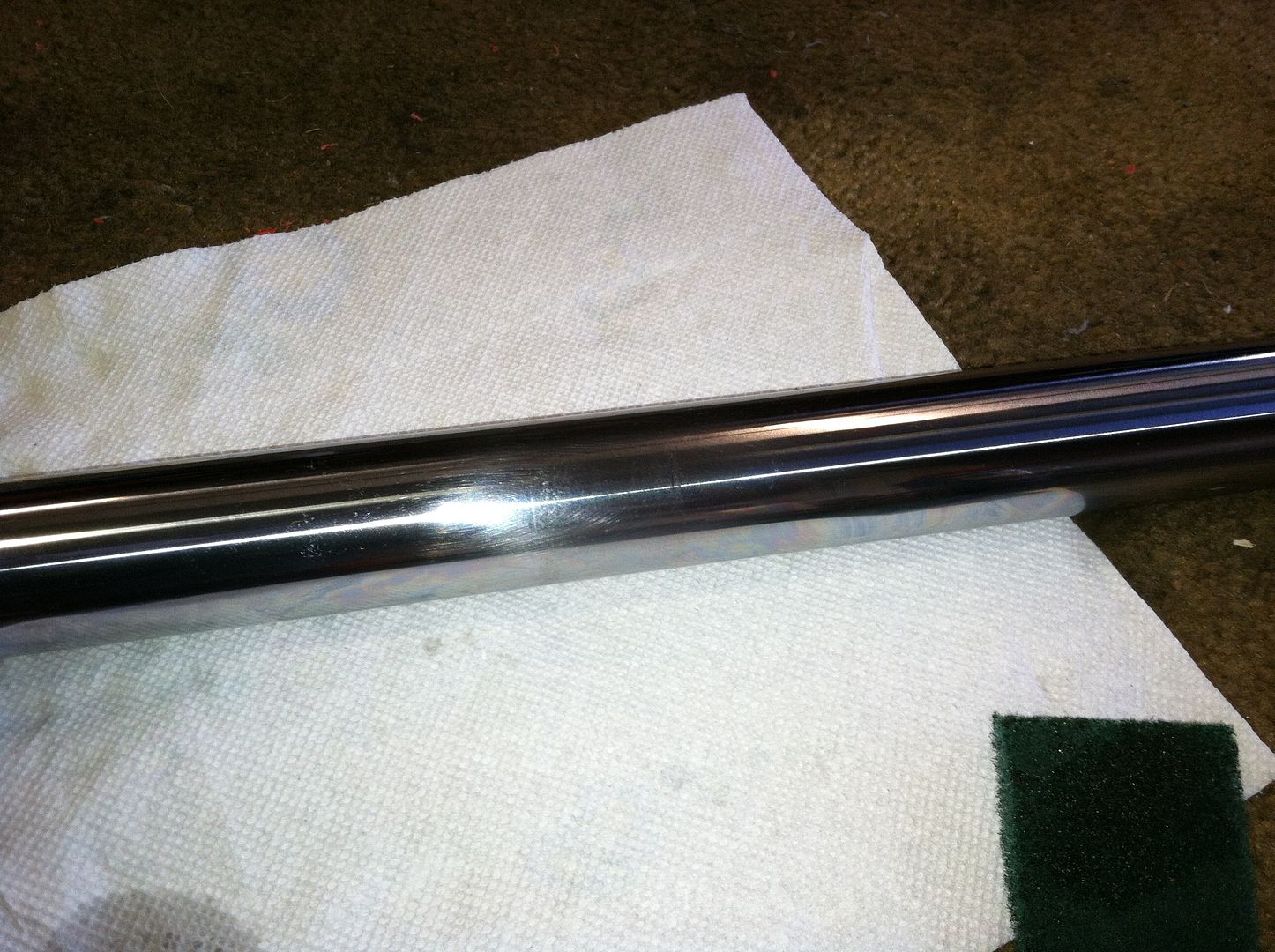
With the forks reinstalled I eagerly measured the sag and was bewildered to find it was 52 mm. Either my original measurements from two years ago were wrong or else the springs had become tired. I checked the free length and the springs were the same length as August 2013, the springs were good so my original sag figure had to be off. The next installment of this thread will be after I install 10 mm longer spacers. Moral of this story is to measure the static sag before taking every thing apart at 27,000 miles.
Bottom Line: The result of the DDCs is very noticeable and I'm happy with the change. The high speed compression damping is transformed. No longer do sharp quick bumps jar the bike and rider but they are largely absorbed by the forks. I know they (bumps) are there but nothing like before. The ride is softer yet more controlled. I have ridden the bike about 200 miles now and really like the change. I can trail brake longer and stronger without having to take into account the way the forks formerly quickly extended and upset my line when I eased off the braking. The rebound damping is improved making the front end more steady when getting off the brakes and back on the throttle. All good.
The zip tie on the tube was there to measure how far the fork compresses during a ride. A poor man's data logger if you will. With the lighter oil and DDC's the max travel has been 115 mm, leaving 22 mm in reserve for a really sharp bump struck under heavy braking. This indicates the spring rate is not too hard for my weight and riding style. A lower oil level, perhaps what Rick first recommended to me - 150 mm, will allow the 22 mm reserve to shrink a little and make the compression damping even more progressive. When I install the longer spacers the ride height will increase and I'll raise the fork tubes in the clamps as necessary to keep my leg reach to the ground the same. More will be revealed.
First, I dropped the forks out of the bike. Rick of Cogent has some pictures on his website showing an install in a bike with the forks still in the bike. It can be done but I wanted to flush the old fork oil out and the forks need to come out for that. I usually change fork oil every 15 to 20,000 miles and I detailed this August 2013 in this thread: http://nc700-forum.com/forum/garage-mechanical-help/3748-fork-oil-change.html. Consult this thread for pics and details on removing the forks and cleaning out the old oil and goop that collects at the bottom of the fork legs. It's surprising how quickly fork oil gets dirty.
This is what the fork tubes look like under the steel lower triple clamp. A nice benefit of regular fork oil changes is controlling the corrosion hidden under the clamp. This happened in 14 months since the August 2013 oil change:


This is one of the Drop-in Damping Cartridges. It is very well made and finished. It's a round piece of aluminum with a large hole in it. Filling the hole is a stack of thin steel shims held in place with that bolt and nut. The bolt has a hole drilled down through the middle of it. It's going to fit closely the inner diameter of the fork tube and sit right under the spring and block the flow of oil as the fork collapses and extends. The hole is designed to pass enough oil to slow (dampen) the fork collapse and extension when in response to a bump or under braking. If the fork collapses slowly as in gentle braking or as when rolling over a small bump the central hole passes enough fork oil to make the damping soft and gentle. If the bump is sharp and quick the shims in the DDC deflect or bend under the rapid rise in oil pressure and enlarge the passage so the oil can still pass through fast enough to gently dampen the bump. That is the main problem I had with the stock fork. I'm 150ish lbs and over small bumps the stock fork worked very well but over a sharp quick or large bump the fork could not dampen the bump fast enough and much of the bump was passed directly to me thru the handlebars and seat as the fork became hydraulically locked and unable to compress fast enough. A suspension tuner would call this good slow speed damping but poor high speed damping with the speed referring to the speed of the fork movement absorbing the bump - not the speed of the bike. The DDC and other cartridge emulators like it (Race Tech, Ricor, others) act to modify the flow rate of fork oil in response to the speed of fork movement in relation to the magnitude of the bump. If the hole (orifice to be technical) is made permanently large enough to give good high speed damping then it would not dampen the slow speed compressions at all. The shims allow tuning to the need of the moment.

You might recognize my home-made oil level tool made of a syringe and a piece of vinyl tubing cut to the length desired. Rick told me to try 130 to 150 mm for the oil level. This level is measured from the top edge of the fork tube down to the top of the oil, fork collapsed, no spring or washers installed. The stock oil level is 104 mm IIRC but Rick told be to try 130 to 150 mm. I set the tool up for 140 mm. The DDC is also pictured. The DDC is a slip fit in the tube but I had to make sure it was seated on top of and centered on top of the stock damping tube. Cogent Dynamics sells a magnet on a stick for this but I had a pick-up magnet that extends long enough to work here:

Now with the fork upright and collapsed I slid the DDC into place and slipped the fork spring over the magnet tool. With the spring in place on top of the DDC I pulled the magnet out.


I'll back up here a bit. With me in full riding gear the fork sagged 55 mm under the weight of bike and rider. This is static or rider sag. 55 mm is 40% of the available fork travel of 137 mm and is quite a lot, really too much. Most tuning guides suggest 25 to 33% of travel and my target was 45 mm or 33%. Even though I knew the original sag was too much I never did anything about it mainly due to my height and inseam plus the bike seemed to work OK with it from the beginning. Without adjustable preload forks the way to adjust sag is to make shorter or longer spacers (Honda calls them spring collars) to fit on top of the springs. I lived with the large sag numbers from mile 1 to mile 27,701 mainly due to my short stature and short inseam. I barely touch the toes of both feet down and raising the front of the bike 10 mm was something I didn't want to do so I lived with it. The 700X has a large amount of travel compared to most street bikes and 33% would work well if I dropped the clamps down the fork tubes the same amount I reduced sag. This will preserve my reach to the ground and keep the fork/frame steering geometry the same. The DDC is 12 mm thick so I thought this additional thickness in the spring stack when in the fork would raise the ride height a large portion of 12 mm and get the sag from 55 to close to 45 mm. With this math in mind (55-12mm =43 mm plus the change would not be linear due to the stock spring's progressive windings) I reused the stock spacers of 150 mm and expected the sag to come out around 45 mm when all was done. I filled with the Cogent Dynamic-recommended Golden Spectro 85/150 oil to the level of 140 mm and after installing the washer and spacer on top of the spring I tightened down the fork caps. I buffed the rust off the tubes with a piece of very fine Scotchbrite and WD40:

With the forks reinstalled I eagerly measured the sag and was bewildered to find it was 52 mm. Either my original measurements from two years ago were wrong or else the springs had become tired. I checked the free length and the springs were the same length as August 2013, the springs were good so my original sag figure had to be off. The next installment of this thread will be after I install 10 mm longer spacers. Moral of this story is to measure the static sag before taking every thing apart at 27,000 miles.
Bottom Line: The result of the DDCs is very noticeable and I'm happy with the change. The high speed compression damping is transformed. No longer do sharp quick bumps jar the bike and rider but they are largely absorbed by the forks. I know they (bumps) are there but nothing like before. The ride is softer yet more controlled. I have ridden the bike about 200 miles now and really like the change. I can trail brake longer and stronger without having to take into account the way the forks formerly quickly extended and upset my line when I eased off the braking. The rebound damping is improved making the front end more steady when getting off the brakes and back on the throttle. All good.
The zip tie on the tube was there to measure how far the fork compresses during a ride. A poor man's data logger if you will. With the lighter oil and DDC's the max travel has been 115 mm, leaving 22 mm in reserve for a really sharp bump struck under heavy braking. This indicates the spring rate is not too hard for my weight and riding style. A lower oil level, perhaps what Rick first recommended to me - 150 mm, will allow the 22 mm reserve to shrink a little and make the compression damping even more progressive. When I install the longer spacers the ride height will increase and I'll raise the fork tubes in the clamps as necessary to keep my leg reach to the ground the same. More will be revealed.
Last edited:


